
The premise that we are all one, is a lie. Though it is true that in GOD we are one. ALL who love God and live by His commandments are one and there is are no differences, there is one race. The children of God. But, currently the world is in the hands of the Fallen and only those who CHOOSE the Creator are covered under that TRUTH.
There are many “religions” and they will all send you to HELL. Religion is man made. God is the ONE and ONLY TRUE AND LIVING GOD. HE ALONE is to be worshiped. ALL other religions are PAGAN. God did not create religion. He is about RELATIONSHIP. The Fall of humanity caused a breach in our relationship with HIM. There was ONLY ONE WAY to repair that breach and restore us to HIM. He needed a man who was without sin, to pay the price for the SIN of rebellion that began in the Garden with Adam. That is why Jesus/Yeshuah came and paid the price so that we could have a way to return to GOD.
This World currently belongs to Satan. And ALL who are not under the BLOOD of Jesus Christ/Yeshuah HaMaschiah are subject to Satan and his minions/demons/Fallen Angels. I believe that for a time/The Time of Gentiles, a restrainere was in place to keep these spirits at bay. BUT, I believe they have been loosed and allowed to operate as they did in ancient times. The ‘Time of the Gentiles” I believe has come to an end. The Gospel has been preached in all the world for a witness. Everyone has had opportunity to hear the GOOD NEW and accept or reject it.
Now, demons are working to bring everything back to the way it was in the “DAYS OF NOAH”. Pagan worship is at an all time high and growing rapidly every day. More and more people are turning to “SPIRITS” for power, for wealth, for provision. They have turned their backs on the Creator and his plan of REDEMPTION. That is why we are seeing the world going to HELL in a handbasket.
People have been conditioned to think that if we all just give up our patriotism, nationalism, and religion we can all blend together and be one big happy family. WRONG!! We are all different. Why? Because we are spiritual beings. Created to worship GOD. We all have minds which hold different values that we have been taught or conditioned to believe by our families, our culture and our environment. We also have our emotional side which drives us to seek fellowship and belonging among others like ourselves. But, most importantly we have a spiritual side. A side that is connected spiritually either to the CREATOR GOD, or to some other spirit. There are many other spirits, but all other spirits are under the headship of Satan. So they are all evil at their root. No godly spirit, no heavenly angel seeks worship. They serve the Creator. So any spirit that is communing with man and seeking gifts..is from the DEVIL/SATAN/THE FALLEN.
BORDERS/BOUNDARIES are a good thing. They define and protect those living within them. They keep all of us safe and at peace because everyone has their place. That is what made the USA so great. We are a nation made up of many different peoples. People tend to gravitate toward people of link mind. States developed over the years and each have their own way of doing things and their own views on political issues. If you are not happy in one State you are free to move to whatever State makes you most comfortable. Each State having the right to make their own judgments and pass their own laws, as long as they don’t violate the NATIONAL LAWS voted on by all the people is what keeps the peace.
The elite are working very hard to destroy all boundaries/borders. They lie to you and tell you they are for FREEDOM. They actually are working to take away ALL YOUR FREEDOMS, ALL YOUR RIGHTS and TOTALLY CONTROL YOUR LIFE. They want to take you back to the Tower of Babel. Back to the days when their was one sovereign and everyone kowtows to HIM. When you can be thrown into the fire for any disobedience.
Law and order and those who protect it (our police and our judicial system) are vital to your freedom and your very existence. Don’t be deceived. It is true that our system has become totally corrupt and broken. So we do need to clean it up. But, we do not need to throw it out. We cannot just destroy the existing system without first re-establishing the rightful order.
This post is created to help you see why we need borders and what happens to our nation when they are invaded, collapsed or removed.
spacer
The following posts are related to this topic, check them out:
spacer
TERMINUS
Be Careful Not to Move the Ancient Boundary Stones
spacer
Events in the Middle East seem to make some commentators and officials forget the fact that borders matter—everywhere, including the Middle East. Most borders reflect the vagaries and irrationalities of history. Sometimes they look arbitrary—history does not usually produce straight lines. Borders frame states, and states are the constituents of the international system and order. Borders bound sovereignty. Their recognition implies acceptance of power within boundaries. For these reasons alone, governments and commentators should take them seriously and be wary of too-easy calls to change them. Just look at the Balkan bloodbaths of the last 150 years for examples other than those in Iraq and Syria of what can happen when borders are torn up or control of borders becomes a politico-military issue. In short, borders are at the heart of international peace, order, and prosperity.

The successful attack on, and rearrangement of, borders should give every state pause. That is what Soviet Foreign Minister Maxim Litvinov meant when, in the 1930s, he said that peace was “indivisible.” The UN Charter emphasizes the sovereign equality of states. The corollary is the prohibition on the threat or use of force against the territorial integrity or political independence of any state.
spacer
The Elites and Open Borders
No one wants to leave his or her own family unprotected. There is no such thing as a true proponent of open borders. It is only a question of what the borders look like — and whom they are designed to protect.
When almost everyone believed in nationalism, or what we used to simply think of as patriotism, borders got drawn around the country as a whole. Nobody questioned it, or even thought about it. The border was defended by the military and the border patrol. America, the “national family” in the public mind, was defined by the people whom the border protected — the citizens of the United States. In the current, post-nationalist way of thinking that is the brainchild of progressives, the elites who advocate for open borders certainly don’t intend to let American riffraff into their neighborhoods — let alone the great unwashed of foreign shores. Their borders are the gated community, the homeowner’s association, the local police or private security, and, in the case of high government officials, the Secret Service. The polity are the political, media, and academic elites and their retainers. To them, what it is important to protect is no longer the nation, but rather the class.
This modern conception of borders is, in some ways, a throwback to the Middle Ages, when the landed aristocracy lived in castles with retinues of armed men, and had a deeper sense of kinship with the nobility of other nations than they had with their own peasants. In some ways, unfortunately, the current state of affairs is worse than medieval. In the Middle Ages, a large population meant both military power and economic wealth. The nobleman might look down upon the humble peasant, but he had a vested interest in protecting him. Now, in an age in which both wars and industry are increasingly the province of machines, most of the populace yields very little benefit to the people who rule over them. When people vote in line with the aristocracy’s wishes, they retain some marginal political value. When they don’t, they are seen as nothing but a resource-hungry nuisance. The revelations from Wikileaks have shown this clearly. No U.S. citizen now living on the dole should be fooled into believing that the elites look down from their high places with loving concern. Peons are not cherished. Moreover, a dirty peon of one’s own country is no better than a dirty peon of a foreign one. Citizenship is a concept that progressives have slated for destruction, as it gives rights to people with whom the elites feel no particular kinship. To the remarkably insular ruling class, the people who run the machines and make the lattes are fungible. That we are deemed “deplorable” as soon as we rebel against the interests of the elites should come as no surprise. If the ragged remnants of our democratic institutions can ever be dissolved or fully nullified, we will find out just how little we matter. Some of us are finding out already.
One need look no further for hard evidence of this process than the current state of the black community. Perhaps the welfare programs of the 1960s and 1970s really were an attempt to fix the problems of the ghetto, but by any measure other than the simple alleviation of hunger, the welfare state has made things worse. There is now more illegitimacy, more crime, more drugs, and fewer jobs in predominantly black communities than there were in 1960. However, the gated community, the homeowner’s association, and the local police in the most affluent neighborhoods make this a distant and rather academic problem for the ruling class. The failure of social programs to eliminate actual poverty has had no real consequences for policy makers themselves. So why should they care? Impoverished, miseducated people living on the taxpayer’s largess can usually be counted on to vote for the people who confiscate their livelihood for them. Conveniently, the Black Lives Matter narrative — that the racist police that patrol the ghetto are the oppressive force that keeps the black population down — does no substantive harm to the elites either. Policymakers do not own the little businesses that end up getting burned or looted in riots. Those belong to peons of one sort or another, and are expendable. The political class can only be glad for a narrative that absolves their failed policies of any culpability. Section 8 housing subsidies that relocate the decivilized populations of the inner cities to middle class neighborhoods never deposit their beneficiaries in Georgetown, Marin County, or the Hamptons. Chappaqua NY, where Hillary Clinton lives, has an African-American population of a mere 0.94% — and those are, no doubt, well-educated and successful professionals like everybody else in Chappaqua. To the elites, middle class neighborhoods and poor neighborhoods are functionally indistinguishable –– both places they never visit, populated by unfortunates and inferiors in a variety of unpleasant shapes, sizes and colors. A person who lives in Bethesda (an affluent suburb of Washington DC) is far more likely to visit the nicer parts of London or Paris than any part of SE Washington. A defended border around the U.S. makes no sense to such a person. Their true nation consists of an archipelago of protected enclaves of their own kind scattered here and there across the Western world.
The question of Islamic migrants yields entirely the same story. Any Muslims who live among the elites are themselves educated — and largely westernized — elites. You will find no Syrian refugees in Georgetown, Marin County, or the Hamptons for the same reason you will find no Section 8 housing there. So long as terrorists only kill off members of the lower classes, the damage they do can be seen as a statistical abstraction. If you look at Islamic terrorism statistically, the numbers of victims are indeed quite small – far, far fewer than the numbers accounted for by ordinary crime or traffic accidents. When Obama said groups like ISIL (ISIS) are not an existential threat to the U.S. — this is exactly what he meant. There are more than 300 million Americans. What’s a few dozen, a few hundred, or even a few thousand more or less? Stalin said famously — “The death of one man is a tragedy, the death of millions is a statistic.” The problem for us is that we are among the rats rather than among the experimenters. That more people die in traffic accidents is not the point. The government makes some effort to reduce the death toll from traffic accidents. In the case of the dangers posed by Islamic migrants, however, the elites have taken the position that a few deaths among the peasantry are more than worth the perpetuation of their diversity meme. They were shaken by 9/11 — but only because that attack managed to kill a few of their own.
While I cannot, in good conscience, recommend actually hating anyone, I have come to find the passivity and naïve optimism of many of my fellow middle class citizens unbearable. The daily drumbeat of outrages against the great sleepy bulk of the American public should not be, and cannot be, ignored. Our republic has been quietly suspended, not in favor of a better and more modern form of government, but in favor of a far older and infinitely worse one. Friedrich Hayek warned us this was coming in The Road to Serfdom — and now it has arrived. We are ruled with no less callous disregard than we might expect if we’d been invaded by a foreign army. Any customer picked at random from a Walmart in the heartland of America would probably serve the public interests better than either the Democratic nominee, or the current Republican Speaker of the House
spacer
Why the Globalists Want Open Borders

When I graduated from Angelo State University many decades ago, I had a chance to go Italy with many of my fellow art majors.
Having excelled in the study of the Italian Renaissance, such a trip greatly appealed to me. Alas, I was poor.
At night I worked at a bakery while going to school full time. I had rent and bills to pay and I didn’t have any savings for such a vacation.
The head of the fine art department, Dr. Otis Lumpkin, offered me some financial aid. He was a great professor,
but I had a new job awaiting me at the local newspaper.
It was a chance to work at a desk while doing something I enjoyed — graphic arts — and I didn’t want to put that off. I figured I could always go to Europe later on my own time and dime.
It never happened for various reasons. Now I’m not sure I would like what I see if I do finally make the trip. Will Europe be recognizable if Islam continues to gain power there?
“No go” zones continue to expand while those who complain are arrested for “hate speech.” The complainers are labeled Oh no! Populism and nationalism are supposed to be terrible things according to the left.
We’re supposed to love everyone and have open borders. We’re all the same, right? Wrong. People and cultures are different. Too much diversity inevitably leads to conflict.
Ostensibly, the “immigrants” were brought into Europe to boost the economy and do the work that the citizens wouldn’t do. (Sound familiar?). Instead, they were put on the dole. They got free stuff while outbreeding the locals.
They brought their aggressive religion with them. Far too many refuse to assimilate. Why should they? Islam tells them that they are superior.
Today, (in Europe) Mohammed is one of the top names for newborn boys. Sharia courts are springing up unopposed. Western civilization is treated with disdain.
Women are raped and the police look the other way due to political correctness.
Why are we seeing this self-immolation by the west? Because lefty loons and George Soros want it.
They want to tear down western civilization to easily usher in globalism to Europe and America. We are beginning to see some push back. The Brexit vote and the election of Trump signaled that citizens have had enough, but there is much more to be done.
Soros needs to be arrested. Merkel needs to be thrown out of office. Mass immigration needs to end.
I want the countries in Europe to keep their identities, languages and cultures. I don’t want to visit Turkey in Germany, Somalia in Italy or Syria in France. If I wanted to go to Saudi Arabia, I would.
I don’t want to see their oppression when I go to Europe. If we want to help the populace of the third world, fine. But keep them in their own countries while doing it. We don’t need to import them and their problems to the west. Source
Yuval Noah Harari is the author of international bestseller “Sapiens: A Brief History of Humankind” (2014) and “Homo Deus: A Brief History of Tomorrow.” In his books, Harari promotes a future filled with transhumanism, upgraded super-humans who dominate the world, and a technocratic elite class where big tech companies like Facebook and Amazon are the new gods. Not surprisingly, Mark Zuckerberg is an open supporter of Harari stating his work is “a big history narrative of human civilization.”
Well, the documented evidence on Harari just keeps piling up. His most recent report paints a picture of the future where the technocratic elite decide whether or not you and I are useful. And even goes on to state that those who aren’t useful won’t last.
While those who support Harari claim him to be an innovative thinker, we beg to differ. This article will prove that the statements Harari is making aren’t anything new, they were first ideas of the society that pulls the strings of the United Nations, the Club of Rome.
“Microelectronics and Society: For Better or for Worse” was originally published in 1982 by the Club of Rome and contains the exact “thoughts” of Harari simply reworded. I will put the quotes side by side with the Club of Rome’s words being in blue to show the similarity and just how downright degrading they are toward humanity.
Yuval Harari:
“The social and economic models we have inherited from the previous century might become utterly irrelevant in coming decades, as the masses lose their economic value.
In 2016, many Brits and Americans who had lost their economic usefulness but retained some political power used the ballot box to revolt before it is too late. They revolt not against an economic elite that exploits them, but against an economic elite that doesn’t need them anymore. It is far more frightening to be useless than to be exploited.”
Yuval Harari just called all those in favor of Trump and Brexit useless eaters, claiming that the elite no longer need to exploit and use them as the masses have lost their economic value, you can’t get much more degrading than that! The worst part is that what he’s saying actually perfectly aligns with the elitist’s ideology.
He continues, “Of course, some new human jobs will develop in the 21st century, be it in engineering software or teaching yoga. Yet these will demand high levels of expertise and creativity, and will therefore not solve the problems of unemployed, unskilled laborers.
During previous waves of automation, people could usually switch from one low-skill job to another. In 1920, a farm worker laid off because of the mechanization of agriculture could find a new job in a factory producing tractors. In 1980, an unemployed factory worker could start working as a cashier in a supermarket. Such occupational changes were feasible, because the move from the farm to the factory and from the factory to the supermarket required only limited retraining.
But in 2040, a cashier or textile worker losing a job to an AI machine will hardly be able to start working as a software engineer or a yoga teacher. They will not have the necessary skills.”
The Club of Rome in Microelectronics and Society (1982):
In other words: the traditional working class will diminish or vanish (as was foreseen by Marx in the mid-nineteenth century) as an effect of automation. The same will, to a large extent, apply to farm laborers, clerks, and a considerable part of the people now employed in the services. But the various traditional fields, especially those connected with intellectual functions, will remain, and in some cases will absorb increased numbers of people.
According to the hypothesis of this paper, namely, that microelectronics will play the leading technical role within the next decade, there seems to be no room for an industrial or a post-industrial society. Both sectors, industry as a whole and public and private services, will lose employment possibilities which now exist. And agriculture will continue to replace workers and farmers through the effects of the so-called “green revolution.”
Yuval Harari:
“Yet with the rise of AI, robots and 3-D printers, cheap labor will become far less important, and demand for raw materials might also drop. Instead of manufacturing a shirt in Dhaka and shipping it all the way to New York, you could buy the shirt’s code online from Amazon and print it in Manhattan. Zara and Prada stores could be replaced by 3-D printing centers, and some people might even have such printers at home.
The newly unemployed workers and call center operators in Dhaka and Bangalore don’t have the education necessary to switch to designing fashionable shirts or writing computer code — so how will they survive?
Under this scenario, the revenue that previously flowed to South Asia will now fill the coffers of a few tech giants in California, leading to huge strain on developing economies.”
The Club of Rome in Microelectronics and Society (1982):
“Such offshore assembly has brought considerable earnings to Asian and some Latin American countries, but it has some questionable features. It employs many low-paid, low-skilled workers in highly regimented and repetitive work, involving hours of manipulation done while peering through microscopes. Such work is not only costly when undertaken in the northern countries, but is subject to much stricter work and health regulation. The job creation resulting from such arrangements is likely to slow down considerably and may eventually disappear.”
Yuval Harari:
“Another major difficulty is that there is no accepted definition for “basic” needs. From a purely biological perspective, the only thing a Homo sapiens needs for survival is about 2,500 calories of food per day.”
In their book, “Mankind at the Turning Point,” the depopulationists of the Club of Rome insert a table on page 194 that shows just how many calories a human needs to survive, as well as showing the amount of that that should be protein. They too say that humans need 2200-3000 calories to live, which is a far cry from the American average caloric intake of 3,770 (evok.ie).
Yuval Harari:
“Hence, even if universal basic income means that poor people in 2050 will enjoy much better medical care and education than today, they might still feel that the system is rigged against them, that the government serves only the super-rich, and that the future will be even worse for them and their children.
Similarly, if in 2050 you tell the useless class that they enjoy better health care than in 2017, it might be very cold comfort to them, because they would be comparing themselves to the upgraded super-humans who dominate the world.”
In conclusion, there is nothing novel about Yuval Harari’s thoughts; his work is merely a carbon copy of the Club of Rome’s from the 1980’s, which makes you wonder…who’s outdated now?

 The current White House administration is overseeing record influxes of immigrants coming across our borders. During 2021, U.S. Customs and Border Protection (CBP) encountered 1.74 million illegal aliens — a record — up roughly 380 percent from the 458,088 encountered in 2020. This surge in illegal aliens at our southern border is the result of candidate Biden’s having invited illegals to come to America once he became president.
The current White House administration is overseeing record influxes of immigrants coming across our borders. During 2021, U.S. Customs and Border Protection (CBP) encountered 1.74 million illegal aliens — a record — up roughly 380 percent from the 458,088 encountered in 2020. This surge in illegal aliens at our southern border is the result of candidate Biden’s having invited illegals to come to America once he became president.
Connect with others in your state in prayer.
This invitation signaled to the drug cartels and crime syndicates that our borders were open for them to exploit. These evil empires then sent word through their networks that they would provide passage and entrance to the United States for a payment. The 2021 surge will be exceeded by over 2 million this year. This translates to over 8,000 illegal crossings per day.
But the numbers of people coming across is only part of the problem. The porous border has created a deadly deluge of illegal narcotics. CBP agents seized an unprecedented 10,500 pounds of fentanyl in 2021, and seizures have already surpassed 12,000 pounds in 2022.
According to Yahoo News, “drug overdoses (led by fentanyl) were the No. 1 cause of death for U.S. adults between the ages of 18 and 45 in 2020 and 2021, according to an analysis of Centers for Disease Control and Prevention (CDC) data by the anti-fentanyl nonprofit Families Against Fentanyl (FAF).
“U.S. life expectancy fell to its lowest point since 1996 in 2021, with 10% of the decline attributed to drug overdoses.”
Drug traffickers understand the incredibly addictive nature of fentanyl and are utilizing any “power” they can in order to deliver it. Apparently, one of these powers is Santería, a religion that has West African roots with Caribbean and Catholic influences. Its dark history revolves around invoking the assistance of “saints,” which are really demonic entities. The rituals and ceremonies are used to release these demonic entities for such things as protection of drug traffic routes.
Over the past few years, numerous reports describe decapitated goats found along highways and in a river. The New Yorker reported recently about this occurring in Atlanta, a known drug hub for the cartels.
Hundreds of headless goats have washed ashore at the Chattahoochee River. Retired El Paso Deputy Police Chief Robert Almonte said he wasn’t surprised. “I’m seeing more and more of the drug traffickers using Santería for protection over the last couple of years,” he said, as reported in The New Yorker. “But that’s a lot of goats. That would mean they’re moving a lot of drugs along that highway.”
An expert in Santería interviewed by The New Yorker expressed uncertainty about the headless goats in the river as signs of drug couriers offering sacrifices. He is quoted as saying: “If it was Santería, the fact that it was by a river means that it was an offering to Oshun, the goddess of love. Not exactly the kind of orisha that you want to sacrifice to smuggle drugs.”
IFA intercessors offered insight in the comments on the article about this posted at IFAPray.org.
David posted this, confirming the connection between border crossers, drugs, and the occult: “Several years ago I spent some time talking to a sergeant at my local sheriff’s office. Our discussion got into some things I wanted him to know about satanists in the government. He had no problem believing me because he had some encounters with satanists himself in the course of his duties. He said that every Mexican drug dealer he arrested in our county was into satanism. He discovered that they spend time at satanist altars in Mexico before crossing the border in an effort to get Satan’s protection. Obviously, their arrests in my county proved Satan can’t protect them when God intervenes through local law enforcement. We need to pray for our local police so God can do this.”
But what about the river sacrifice indicating the Santería goddess of love? KG posted this: “I live in the Atlanta Metro area. I know what is going on right in that area (it’s near 6 Flags amusement park). It is a HUGE sex trafficking area – I have been involved in mission work there. When I read about that area and the goddess of love, this is exactly what I thought of. Every time I pass that area, I pray for the souls of those trapped in those hotels right along that same stretch of the Chattahoochee. I have seen firsthand the evil that is on that street right before the happiness of 6 Flags. This is so disturbing to read this but thank you for the article to remind us to release angels to this area and this industry.”
The Lord has revealed discernment for our intercession. Satanic drug and sex traffickers cross our porous borders and practice deep levels of occultic activity in our communities to protect and perpetuate their evil activities.
“So they shall no more sacrifice their sacrifices to goat demons, after whom they whore. This shall be a statute forever for them throughout their generations” (Leviticus 17:7).
We can and must pray about this issue:
Father, You are the ruler of all, and You have the power to restrain all evil. We ask that You would guide our lawmakers to protect our nation through strong borders. We ask that You would cause media outlets to accurately describe drug and sex trafficking as well as occult activity so that the public would object to the evil that is pouring into our nation. We claim Acts 17:26, which declares that You have “marked out the … boundaries” of our nation. We declare Colossians 2:15, which says that You “disarmed the rulers and authorities and put them to open shame, by triumphing over them.”
Please join us in the battle. Add your discernment and/or your prayers in the comments and share this article so the Church can stand against this evil in our nation.
spacer
style=”font-size: 18pt;”>The Mystery of the Headless Goats in the Chattahoochee
After my mom retired, Jason Ulseth became the riverkeeper, assuming all boat-related duties. One October a few years ago, he took three of the group’s donors, all women in middle age, on a two-hour tour of the river that included a stretch ten miles west of downtown Atlanta, where the Chattahoochee passes a Six Flags Theme Park and goes under an I-20 bridge. Ulseth had boated it a hundred times before. “But, this time,” he told me recently, “I saw something white off on the side near the bridge.” He pulled the boat over to the bank. “There were eight or nine baby decapitated goats just floating in the water. The ladies flipped their shit.”
Others have found them, too. “Half the time we boat by the bridge, I smell them,” Matt Robinson, a local fishing guide, told me. He’s seen hundreds, he said, including thirty on a single trip. “I’m sure some catfish or some turtles chew on them once in a while,” he added. “They’re pretty big animals.”
A few years ago, Robinson introduced Ulseth to a man who was living under the I-20 bridge, who called himself Hot Dog. Hot Dog took pictures and videos of the goats on a cell phone, sometimes capturing the moment they were flung from the highway. He told Robinson that the goats were usually freshly killed, and he shared some of his photos with Ulseth, who showed them to me: headless goat carcasses falling from the sky. “They just go plop,” Ulseth said. “Could be two in the morning or two in the afternoon.”
The carcasses sometimes get caught midcurrent by downed trees or underwater debris; some end up among heaps of trash along the bank. Others have lately shown up farther afield. “We just found a big pile of them dumped in the Chattahoochee River National Recreation Area last week, at a boat ramp,” Ulseth said, referring to a spot about forty miles upriver that paddlers and other recreationalists have long used to enter and exit the water. “They were all covered in maggots when I got there. Pretty disgusting.” It was not his worst encounter: he once found three such carcasses rotting inside a floating burlap sack, which he had opened “in case it was a body and needed to be reported,” he said.
The case of the headless goats is a mystery. It’s also a public-health hazard, and a nightmare for a stretch of river that’s newly safe for recreation—the water south of Atlanta is dramatically less polluted than it was decades ago, thanks in large part to C.R.K.’s work. Private developers and local governments have begun installing boat ramps and other infrastructure to make the area more accessible. “A family can now have a nice paddle on the river and then take out right there near Six Flags,” Ulseth told me. “But, as soon as someone paddles down and sees that crap,” he said, referring to the goat carcasses, “they’re never coming back.”
One theory about the headless goats of the Chattahoochee focusses on the Afro-Caribbean religious tradition Santería, also known as Lukumí and La Regla de Ocha. The practice sometimes involves animal sacrifice. A similar theory was floated several years ago, when numerous goat heads turned up in and around Prospect Park, in Brooklyn. In both cases, no one has established a definitive connection, at least not publicly. (Santeria also at time REQUIRES HUMAN SACRIFICE.
I called former agents with the Georgia Bureau of Investigation to see if they had heard of any leads. One directed me to Robert Almonte, a retired deputy chief of the El Paso Police Department, who worked a number of narcotics investigations, then served as the U.S. Marshall for the Western District of Texas from 2010 to 2016. He has since founded a consulting company that specializes in the activities of Mexican drug cartels, including how “they involve the spiritual world in their activities,” as Almonte put it. Almonte offers seminars, which, he told me, help law-enforcement agents identify likely perpetrators. (He says that several major arrests of cartel members have resulted from these seminars.)
I told Almonte about what was turning up in the Chattahoochee. He didn’t sound surprised. “I’m seeing more and more of the drug traffickers using Santería for protection over the last couple of years,” he said. “But that’s a lot of goats. That would mean they’re moving a lot of drugs along that highway.”
Drug smugglers have long attempted to exploit religion for their own purposes, Almonte said. “Back in the day, on raids, we’d mostly see shrines and altars,” he told me. “But it usually consisted of prayer candles related to the Catholic Church.” Now, he said, “you’re seeing more cartel traffickers using Santería” and Palo Mayombe, an Afro-Caribbean religious tradition, as well as a Latin American practice called Santa Muerte. The traffickers are not necessarily well schooled in these traditions, Almonte noted—he told me that when he shows pictures of headless goats that have been found to experts in Santería, “They often say, ‘Yeah, this guy doesn’t know what he’s doing.’ ”
Almonte had just returned from a trip to Mexico, where he was researching a case involving a drug cartel called La Unión Tepito. The case was set in motion in 2019, by a raid, in Mexico City, of a drug house which had spiritual paraphernalia inside it. The raid turned up massive quantities of methamphetamine, plus grenades, a rocket launcher, and items evidently associated with both Santería and Palo Mayombe, according to Almonte.
Atlanta has long been a major drug-trafficking hub, dating back to at least when the late Colombian drug lord Pablo Escobar transported cocaine from Miami to Atlanta and points beyond. “It’s been a plaza for many years for the Sinaloa cartel,” Almonte told me. “Several years ago,” he added, “you had the Jalisco New Generation cartel”—Sinaloa’s chief rival—“move in.”
Almonte figures that Mexican cartel operators could be sacrificing goats for safe passage to or from Atlanta, and dumping them in the river. He said that he wouldn’t be surprised if the G.B.I. or the F.B.I. is investigating the connection between the goats and drug trafficking; later, someone with direct knowledge of the matter confirmed to me the existence of such an investigation. (“There is no G.B.I. investigation,” a spokesperson for that agency told me. “I’d recommend checking in with the F.B.I.” An F.B.I. spokesperson told me, “We can’t discuss or acknowledge the existence of any current or potential future investigation.”)
After speaking with Almonte, I called up Miguel De La Torre, a professor of social ethics at the Iliff School of Theology, in Denver, who grew up practicing Santería and has written extensively on the subject. He describes himself as “a Roman Catholic–Southern Baptist Santero, who still follows some of the Santería traditions though I may not believe in it.” I described the situation, and explained Almonte’s theory. “There are certain religious traditions where animal sacrifices are made to gain enough power to accomplish something,” De La Torre said. “The strongest energy, the strongest power, is in blood. But I’m always a little hesitant when a dead animal is found and it’s connected to Santería.” Many of those who study Santería are frustrated by the eagerness of outsiders to connect any unexplained dead animal to the practices of this tradition. De La Torre did not think that the connection between Santería and smuggling was clearly established—and the location of the headless goats in the Chattahoochee struck him as odd. ” “If it was Santería, the fact that it was by a river means that it was an offering to Oshun, the goddess of love,he explained. “Not exactly the kind of orisha that you want to sacrifice to to smuggle drugs.”
Still, De La Torre conceded that the headless goats could be the work of spiritual opportunists, “copycatting Santería” for their own purposes. “Drug dealers who are not part of the religion but are making it up as they go along based on what they read on the Web,” as he put it. He offered an analogy. “It’s like not knowing anything about Catholicism and bathing in holy water because you think it’s gonna help you.”
One Monday morning, earlier this month, I got in a boat with Ulseth. My mom came, too; she wanted “to see what this whole crazy goat thing is about,” she said. We put in downstream from the bridge. Motoring against the current, we saw an osprey, a snowy white egret, a hawk, a great blue heron, a few kingfishers and buzzards, and dozens of turtles sunning themselves on logs and rocks. We also saw Styrofoam containers, a plastic chair, two rafts, a basketball, and discarded tires trapped by downed trees and marooned in the mud along the bank.
We got out at a dock and walked around new apartments built a little ways back from where junk yards once teetered on the edge of the river. Farther on, we stopped to marvel at a Six Flags roller coaster rising from river right (the Mindbender, bane of my anxious childhood).
Then we came upon a decapitated goat, caught in a pile of trash between a downed tree and the riverbank. “This one was probably dumped over the weekend,” Ulseth told us.
“Holy fucking shit,” my mom said, overwhelmed by the stench.
“That’s the neck right there,” Ulseth continued, pointing to a fleshy stump. “We’re a little further downstream than where we normally find them,” he added. “So probably we’re going to find a lot more.”
In the next hour, we found six headless goats. “I just got punched in the face,” Ulseth said as we approached the reeking sequel to the first. It was covered in flies and maggots. “That one’s been there a little longer,” Ulseth said. We saw a third, and then, every five minutes or so, we’d first smell and then see another headless goat bobbing in the water.
We reached the highway bridge. Beneath it was a platform and a blue tarp; on a concrete column, the words “hot dog” and “god is good” had been painted. Ulseth told me that Hot Dog claimed to have confronted the carcass-discarders with a gun, after one too many goats had been dropped near his camp. “If you motherfuckers ever come back here, I’m gonna blow your head off,” he supposedly told them. Ulseth said he later saw the gun in question, under the bridge. (“It shot those rubber pellets,” he said.) Had Hot Dog, whom Ulseth hadn’t seen recently, ever shared details about the identities of the goat dumpers? What they looked like, or anything they said? “Nope.”
A week after our trip up the river, Ulseth went out on the same stretch again and found fifteen headless goats. “Maybe a few repeats,” he said. “But a lot of goats.”
When I first spoke to De La Torre, he said that if he were going to use Santería to gain protection for smuggling drugs, he’d probably sacrifice a black dog, because that is what Oggun, a warrior deity, would want. He’d leave the dog’s body by a railroad track, because Oggun is also lord of iron, he added. But he followed up by e-mail a few days later. “The more I think of it, the goat is one of the preferred sacrifices of Elegguá,” another orisha, “who ‘opens the way,’ he wrote. A sacrifice to Elegguá would typically be “left by a four-way street crossing.” Goats and highways, in other words, made some sense to him. But a headless goat, in a river? That was harder to understand. ♦ (This guy De La Torre can only speak on HIS experience both with the religion and with particular spirits he has dealt with. He does not know anything about any other person or groups of persons and their interactions with spirits, nor does he know everything about spirits/demons/fallen angels and their progeny and the things they demand of their worhipers and servants.)
spacer
Mexican border family suspected of human sacrifice
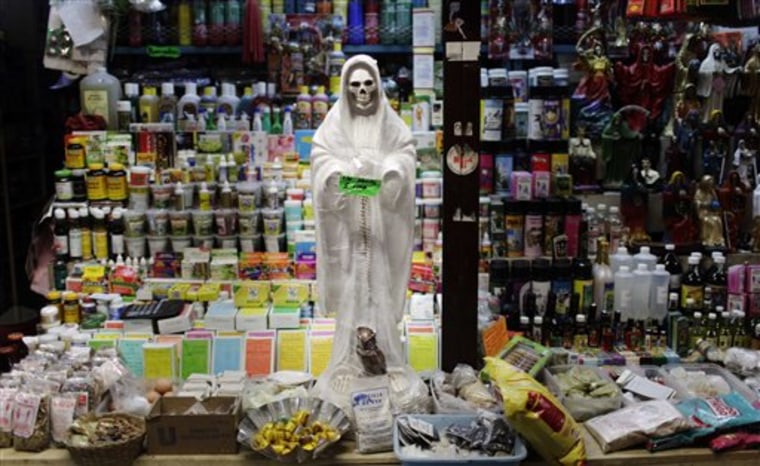
Eight people have been arrested for allegedly killing two boys and a woman in ritual sacrifices by the cult of La Santa Muerte, or Saint Death.Rodrigo Abd / AP
It was a family people took pity on, one the government and church helped with free food, used clothes, and farm animals. The men were known as trash pickers. Some of the women were suspected of prostitution.
Mexican prosecutors are investigating the poor family living in shacks outside a small town near the U.S. border as alleged members of a cult that sacrificed two 10-year-old boys and a 55-year-old woman to Santa Muerte, or Saint Death, a figure adored mostly by outlaws but whose popularity is growing across Mexico and among Hispanics in the United States.
The killings have shocked the copper mining village of Nacozari, on the edge of the Sierra Madre, and may be the first ritual sacrifices linked to the popular saint condemned by the Roman Catholic Church.
Authorities say the throats and the wrists of the victims were cut with knives and axes, and their blood was spread on a Santa Muerte altar. Their bodies were then buried near the shacks where the alleged cult members lived.
“We never knew they were part of a Santa Muerte cult,” said Jorge Sanchez Castillo, a 54-year-old hotel owner who has a corn field next to the house of the woman believed to lead the group. “This has been tragic for all of us.”
Nacozari has been spared the grisly violence of drug cartels fighting for lucrative corridors along the U.S.-Mexico border, said police chief Jose Miguel Espinoza.
“It was a peaceful town. We’d never seen such violence,” he said.
When a 10-year-old boy went missing in July 2010, his mother and her boyfriend told police that acquaintances had seen him begging in the streets of nearby Agua Prieta across the border from Douglas, Arizona, and that they would go find him, said Espinoza.
“We had no reason to suspect it was a homicide,” he said.
A second 10-year-old boy went missing in early March, prompting Sonora state’s missing persons unit to send agents to Nacozari, said the police chief. That boy’s mother and her boyfriend reported it to state authorities, who discovered weeks later that the two boys knew people in common.
The missing boy Martin Rios was the son of the ex-girlfriend of a man named Eduardo Sanchez. The second boy, Jesus Martinez, was the step-grandson of Eduardo Sanchez’s new girlfriend Silvia Meraz.
spacer
Mexican authorities find 7 dead bodies along road in popular tourist area
Officials in Mexico said the bodies were found with extensive bruising suggesting they had been beaten as cartel violence remains a top concern
Published
Fox News contributor Tom Homan on the migrant surge.
Mexican authorities say they have discovered the bodies of seven men dumped on a road in a region popular with tourists.
Authorities say the bodies of seven men were found dumped on a roadway late Thursday in the Huasteca region with extensive bruising that suggest they were beaten.
Writing scrawled in markers on the corpses said “this is what happened to me for working with the Gulf,” an apparent reference to the Gulf cartel, which operates mainly along the U.S. border to the north.
The messages were signed “Valles Operation O.B.,” apparently a reference to a rival gang.
MASSIVE MIGRANT CARAVAN DISBANDS AS MEXICO HANDS OUT TRAVEL PERMITS; MIGRANTS EXPECTED TO HEAD TO US
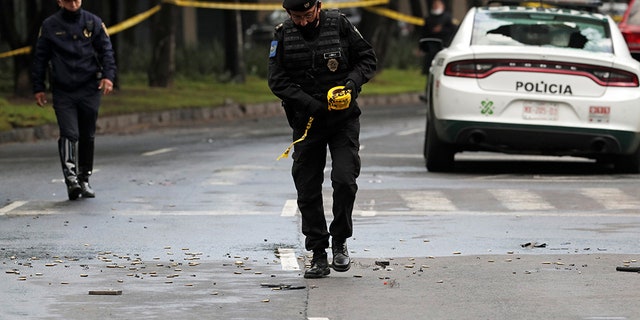
A police officer walks amid ammunition near the scene of a shooting in Mexico City, Mexico
Prosecutors in San Luis Potosi state said late Thursday the bodies did not appear to be from the township of Aquismon, and may have been killed elsewhere and dumped in the rural area
The Huasteca region has long been popular with Mexican tourists for its waterfalls and crystalline rivers.
Cartel violence is also being blamed for simultaneous shooting attacks at two bars in north-central Mexico in late May that left 11 people dead.
Handwritten signs left at the scenes of the killings suggested the attacks were part of a rivalry between two drug cartels that have been battling for control of Guanajuato state for several years.
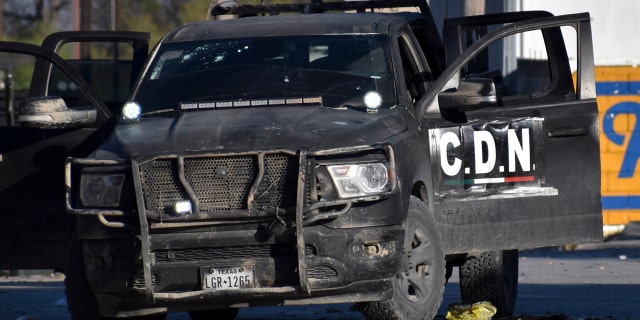
A damaged pick up marked with the initials C.D.N., that in Spanish stand for Cartel of the Northeast (AP Photo/Gerardo Sanchez)
FORMER GULF CARTEL LEADER EXTRADITED FROM MEXICO TO THE US ON COCAINE TRAFFICKING CHARGES
Fox News contributor Tom Homan, former Acting Director of the U.S. Immigration and Customs Enforcement, warned earlier this month that cartel violence will continue to spread into the United States as a result of the Biden administration’s lack of immigration enforcement at the southern border.
“The most treacherous territory is where the convicted criminals and the drug dealers try to move their drugs, because it’s harder to apprehend them,” Homan told “America Reports.”
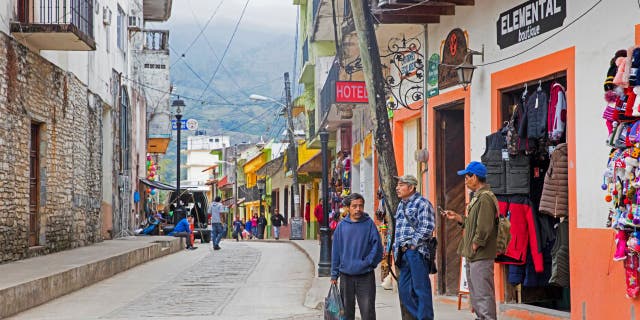
Shops in shopping street in the city Xilitla, San Luis Potosi, Huasteca region, Mexico. (Photo by: Marica van der Meer/Arterra/Universal Images Group via Getty Images)
Homan continued, “You know, only with use of a drone can you see them coming. So, yeah, you’re going to see populations across the entire southwest border. Every sector is going to see an increase because the cartel is going to spread their madness out, right? They’re going to send large groups to a certain area knowing Border Patrol is going to surge resources there. And that’s where they’re going to move the drugs and the convicted criminals, the pedophiles. This again, it’s a worst-case scenario. This administration has sold out our national security.”
Associated Press contributed to this report.
spacer
Bodies found in Mexico town where students vanished
Mexican marines guard the site where a number of bodies were found in unmarked graves on the outskirts of Iguala, Guerrero state, on October 4,2014, the southern Mexico town where 43 students disappeared after a deadly police shooting last week
Iguala de la Independencia (Mexico) (AFP) – Authorities were investigating whether several bodies found in clandestine graves in southern Mexico are those of 43 students who disappeared after a deadly police shooting last week.
The pits were found Saturday on a hill in a community outside Iguala, the town where the students were last seen and where witnesses say municipal police officers whisked several of them away.
Inaky Blanco, chief prosecutor for the violence-plagued state of Guerrero, declined to say how many bodies were buried in the pits outside Iguala, 200 kilometers (125 miles) south of Mexico City.
“We still can’t talk about an exact number of bodies. We are still working at the site,” Blanco told a news conference in the state capital, Chilpancingo.
But two police officers at the scene in the community of Pueblo Viejo told AFP that at least 15 bodies were exhumed from the site, which was cordoned off and guarded by scores of troops and police.
Juan Lopez Villanueva, an official from the National Human Rights Commission, said that six pits were found up a steep hill probably inaccessible by car.
Four forensic services vans left for the morgue late Thursday carrying bodies in silver bags. Authorities are conducting DNA analysis to identify the victims.
The graves were found after some of the 30 suspects detained in the case told authorities about their location, Blanco said. The detainees include 22 police officers and gang members.
If the students are in those pits, it would be one of the worst slaughters that Mexico has witnessed since the drug war intensified in 2006, leaving 80,000 people dead to date.
The students from a teacher training college disappeared last weekend after Iguala police officers shot at buses that the group had seized. Failing to return home after holding fundraising activities on September 26. Three students were killed.
Another three people died when police and suspected gang members shot at another bus carrying football players on the outskirts of town.
A survivor said in an interview that the officers took away 30 to 40 students in patrol cars.
Blanco said investigators had confirmed suspicions that a criminal organization, the Guerreros Unidos, was involved in last week’s crimes and that local police officers belong to the gang.
Authorities have issue an arrest warrant for Iguala’s mayor, who has fled.
– ‘Savagely massacred‘ –
Governor Angel Aguirre appealed for calm in his state, which is mired in poverty, gang violence and social unrest.
“I call on all (Guerrero state residents) to maintain harmony, non-confrontation, and avoid violence,” he said, offering his support to the families of those who were “savagely massacred.”
The missing students are from a teacher training college near Chilpancingo known as a hotbed of protests.
Thousands of students and teachers blocked the highway between Chilpancingo and Acapulco for hours on Thursday, demanding help from federal authorities to find the missing.
The police’s links to organized crime has raised fears about the fate of the students in a country where drug cartels regularly hide bodies in mass graves.
Around 30 bodies were found in mass graves in Iguala alone this year.
“We are very worried. The families are very anxious,” said Vidulfo Rosales, a human rights lawyer representing relatives of the missing.
The United Nations has called the case “one of the most terrible events of recent times.”
spacer

In the early morning hours of March 11, 1989, college students Mark Kilroy, Bill Huddleston, Bradley Moore, and Brent Martin decided their night of partying was at an end. Like tens of thousands of other high school and college kids, they had walked across the international bridge from Brownsville, Texas, to spend part of their spring break in the raunchy border town of Matamoros, Mexico, where the legal drinking age was only 18.
The four longtime friends left the bar and started walking toward the border, where they had parked their car. Along the way, Kilroy said he had to use the bathroom. He ducked into a darkened, overgrown park, only 200 feet from the border. The other three continued, confident that Kilroy would catch up when he’d finished.
They crossed the border and arrived at their car with Kilroy still out of sight. So they waited. After about two hours, they began getting worried. So they went back into Matamoros to look for their friend, to no avail.
The next day, when they still hadn’t heard from Kilroy, they went to the U.S. Consul in Matamoros. The consul assured the boys that Kilroy had probably wandered off and passed out and that he was sure to turn up soon.
But he didn’t turn up. So the boys, along with Kilroy’s parents, went to the Cameron County Sheriff’s Department in Brownsville. There, Lt. George Gravito took their statements.
It sounded like Kilroy had gone missing in Mexico, which was outside his jurisdiction, so he went to the Matamoros police. Gravito’s department had a long history of working with the Matamoros police, so Gravitos was surprised when they claimed that Kilroy had gone missing in the US; therefore, it wasn’t their problem.
There was, however, one agency that was willing to work with Gravito: the Mexican federal police — specifically, their drug enforcement arm under Commandant Juan Benítez Ayala.
The Kilroys, their friends, and both police forces searched for the young pre-med student, pasting up 200,000 flyers — in both Spanish and English — all along the Rio Grande valley. They offered a $15,000 reward. Kilroy’s parents met with officials all along the border, and his case was featured on America’s Most Wanted.
But despite numerous calls and tips, nothing panned out. Kilroy was nowhere to be found, and his case began to go cold.
Three weeks after Kilroy had seemingly vanished into thin air, a strange turn of events would not only uncover what happened to him, but reveal something far more evil and gruesome.
Ayala and his officers were working with American drug enforcement on one of the largest drug interdiction efforts the two agencies had ever executed. As part of that effort, Ayala and some of his officers had set up a roadblock near Matamoros.
All seemed to be normal until one car refused to stop. It drove right through the roadblock, leading to a high-speed chase. The car, with Ayala and his officers behind it, drove to a ranch in Santa Elena, just south of Matamoros. When the driver got out of the car, he seemed surprised that the officers were arresting him.
The officers conducted a search of the property and found hundreds of pounds of marijuana. They also noticed a small shed on the property. A foul, rotten stench emanated from the small structure.Looking inside, they spotted candles, an altar, a large cauldron, and other items they associated with brujería. None of the officers dared to search the shed any further.
Oct 11, 2020

Three weeks after Kilroy had seemingly vanished into thin air, a strange turn of events would not only uncover what happened to him, but reveal something far more evil and gruesome.
Ayala and his officers were working with American drug enforcement on one of the largest drug interdiction efforts the two agencies had ever executed. As part of that effort, Ayala and some of his officers had set up a roadblock near Matamoros.
All seemed to be normal until one car refused to stop. It drove right through the roadblock, leading to a high-speed chase. The car, with Ayala and his officers behind it, drove to a ranch in Santa Elena, just south of Matamoros. When the driver got out of the car, he seemed surprised that the officers were arresting him.
The officers conducted a search of the property and found hundreds of pounds of marijuana. They also noticed a small shed on the property. A foul, rotten stench emanated from the small structure. Looking inside, they spotted candles, an altar, a large cauldron, and other items they associated with brujería. None of the officers dared to search the shed any further.
But the marijuana was a major offense. In addition to the driver, Elio Henandez Rivera, several other men at the ranch were arrested, including Serafín Hernandez and an elderly caretaker.
At the station, the caretaker spotted Kilroy’s missing-person flyer on Ayala’s desk. “I know that man,” he said.
Ayala was listening. The old man told Ayala that he had fed the young man, who he had been bound and held in the back of a Suburban at the ranch three weeks earlier. As for what happened to Kilroy after that, the old man didn’t know.
So Ayala began questioning the Hernandez brothers about Kilroy. None of them would admit knowing anything — except Serafín. He readily admitted that he and his brothers had kidnapped him and taken him to the ranch at the behest of “El Padrino” (the godfather). He said that El Padrino had wanted them to bring him a smart, handsome American, one who was studying to be a doctor.
Why did El Padrino want them to kidnap Kilroy? There had never been any attempt to contact his friends or parents to demand a ransom.
Serafín answered very calmly: El Padrino wanted a human sacrifice.
El Padrino, the officers would soon learn, was Adolfo de Jesús Constanzo. Born in Miami to a Cuban immigrant mother, Constanzo had been raised in the Palo Mayombe tradition, an Afro-Caribbean religion related to Santería, but considered to be much darker. Rituals often include animal sacrifice and the use of human bones — however, human sacrifice is strictly forbidden.
Constanzo’s mother believed her son to be a chosen one, and performed rituals dedicating him to various gods or spirits, and invoking their protection. She believed that he had strong clairvoyant abilities and that he could speak to the dead; they both claimed he had accurately predicted the assassination attempt on Ronald Reagan in 1981.
But she was grooming him for something much darker than telling fortunes. She would make him toture and kill animals, praising him for his cruelty when he did so.
At one point, his mother was arrested for keeping 27 animals in her tiny apartment; the floors were covered in feces and blood.
 When he was 21 years old, his mother performed the final initiation on him, presenting him with a nganga, an iron cauldron central to Palo Mayombe rituals. The nganga is believed to hold the essence of the spirits, and the priest must sacrifice the appropriate items to the nganga to receive various blessings.
When he was 21 years old, his mother performed the final initiation on him, presenting him with a nganga, an iron cauldron central to Palo Mayombe rituals. The nganga is believed to hold the essence of the spirits, and the priest must sacrifice the appropriate items to the nganga to receive various blessings.
Now a full-fledged priest, the good-looking Constanzo was offered a modeling opportunity in Mexico City. He relocated there and worked occasionally as a model. But his primary income came from being a Palero, or Palo Mayombe priest. He opened shop in Mexico City’s Zona Rosa, or pink district, known for being welcoming to gays like Constanzo.
There, he performed various rituals — cleanses, fortune telling, healings, and others — for pay. Some of his clients were extremely wealthy and powerful, including law enforcement officials and drug dealers. The drug dealers, in particular, interested Constanzo, as this was where the real money was. He convinced several high-level drug kingpins that he could cast spells to make them invisible to law enforcement, and that his clairvoyance could tell them which days to move their product safely. In return, the drug dealers paid Constanzo handsomely.
What they didn’t know was that Constanzo was bribing law enforcement officials so he could protect his clients.
It was through his drug connections that Constanzo ended up at the ranch in Santa Elena. It had long been a stopping point on the illegal drug “highway,” but with the death of the owner, the operation was in chaos. Constanzo stepped in, and using his charismatic powers, got the Hernandez brothers to believe in his twisted version of Palo Mayombe, convincing them that he could make them invisible to law enforcement and even bulletproof. Soon he took over the ranch and its operations.
The brothers (along with a few other followers) so believed in El Padrino’s powers that they participated in his rituals — including rituals of human sacrifice.
Ayala took the Hernandez brothers, in handcuffs, back to the ranch. “Show me where the body is,” Ayala commanded.
“Which body?” Serafín asked.
Ayala wasn’t in the mood to play games. But Serafín pointed out that there were several bodies buried on the ranch.
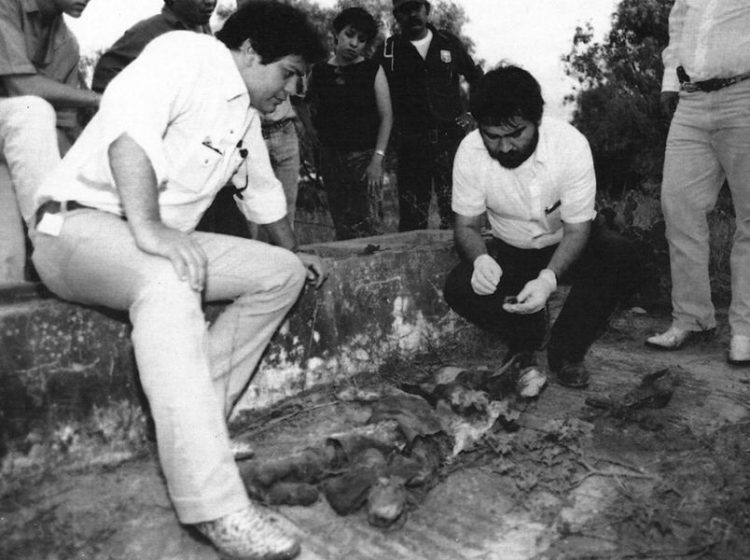 First, however, he was instructed to take them to Kilroy’s remains. He went right to the burial spot, noting Kiroy would be buried where there was a wire sticking out of the ground. Ayala asked why there was a wire there, and Serafín explained that El Padrino had wanted to make a necklace out of Kilroy’s vertebrae, so they had threaded a wire through his spine. That way, once he’d decomposed, El Padrino would only have to pull the wire out.
First, however, he was instructed to take them to Kilroy’s remains. He went right to the burial spot, noting Kiroy would be buried where there was a wire sticking out of the ground. Ayala asked why there was a wire there, and Serafín explained that El Padrino had wanted to make a necklace out of Kilroy’s vertebrae, so they had threaded a wire through his spine. That way, once he’d decomposed, El Padrino would only have to pull the wire out.
When Kilroy’s remains were uncovered, they spoke of a shocking death. His skull had been cut open and his brain removed. His legs had been chopped off below the knees. And his spine had been cut open and threaded with wire, just as Serafín had said.
Speaking casually, with no hint of remorse, Serafín detailed the last hours of Kilroy’s life.
He and his brothers had gone out to the bars, wading through the thousands of American tourists, looking for a victim that fit El Padrino’s criteria. That’s when they found Kilroy. They followed him to the park where he’d stopped to go to the bathroom. There, they flashed fake badges and told him he was under arrest for public drunkeness. They threw him in the back of their van and drove a few blocks away to wait for the other car driven by their brothers.
When they parked, Kilroy actually escaped. He ran, and nearly got away, when one of them shouted in English, “Freeze!” Out of instinct, Kilroy stopped, and the Hernandez brothers caught him and tied him up, placing duct tape over his eyes and mouth.
 Just as the caretaker said, Kilroy had been left in the back of the Suburban at the ranch for several hours, until later that afternoon. That’s when Constanzo arrived and began the ritual.
Just as the caretaker said, Kilroy had been left in the back of the Suburban at the ranch for several hours, until later that afternoon. That’s when Constanzo arrived and began the ritual.
Kilroy was dragged into the shed and forced onto his stomach on the filthy ground. Constanzo then cut his skull open with a machete. He removed Kilroy’s brain and placed it into the nganga, a sacrifice he believed would grant him intelligence and wisdom.
Ayala put the Hernandez brothers to work digging up graves, and even requisitioned a neighbor’s backhoe to aid in the dig. Eventually, they would exhume the remains of 14 more people. All of them had evidence of torture: decapitation, burning, castration, and in at least one victim, removal of his heart.
When police searched the shack, they found evidence that human sacrifice and mutilation had occurred there: a machete caked in blood and tissue; bottles and jars filled with a putrid mix of blood, hair, and 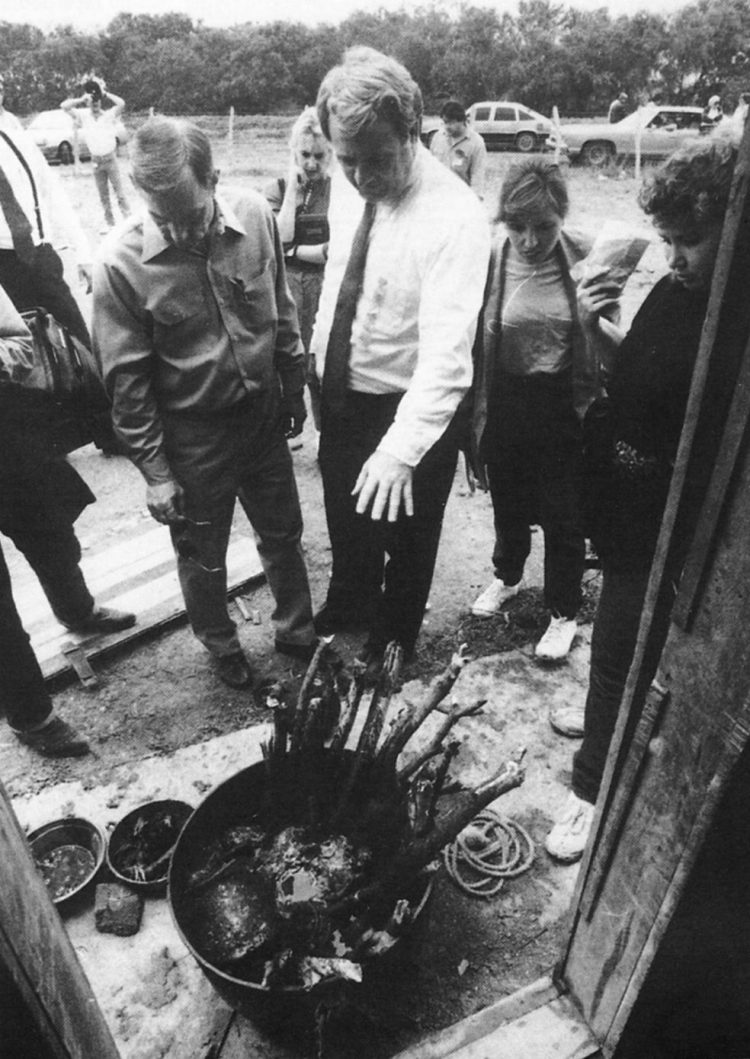 other tissue; a 55-gallon drum apparently used to boil victims’ flesh off their bones. And of course, the nganga, which contained a stew of rotting flesh — both human and animal — including Kilroy’s brain.
other tissue; a 55-gallon drum apparently used to boil victims’ flesh off their bones. And of course, the nganga, which contained a stew of rotting flesh — both human and animal — including Kilroy’s brain.
Although police had the Hernandez brothers and a few other accomplices in custody, Constanzo was in the wind. Thanks to Serafín’s confession, police knew he would be traveling with Sara Aldrete, his high priestess and right hand.
Aldrete was not the type anyone would suspect of belonging to a murderous cult. She was an honor student at Texas’ Southmost College, majoring in physical education. She was known by all the other students as friendly, outgoing, and deeply involved in extracurricular activities. Yet the tall Mexican woman had been working with Constanzo for years, luring victims and recruiting new members.
At first, police feared the couple might have fled to the US. In the days before cell phones or widespread debit-card transactions, they were completely off grid. But police were able to discover that the two had been in the US, where they obtained fake IDs. They then drove to McAllen, Texas, and boarded a plane using their fake identities. Their destination: Mexico City.
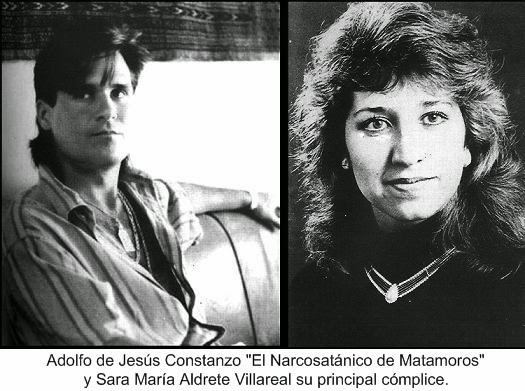 Police searched Constanzo’s various homes and properties in Mexico City, but could not find the couple. By the end of the investigation, however, they would discover more bodies suspected of being killed by Constanzo, bringing the number of known victims to 23.
Police searched Constanzo’s various homes and properties in Mexico City, but could not find the couple. By the end of the investigation, however, they would discover more bodies suspected of being killed by Constanzo, bringing the number of known victims to 23.
The police put up wanted posters and offered a reward. But weeks went by with no luck. So they went to a local anthropologist who specialized in Santería and Palo Mayombe. He suggested that they burn the shack, and most importantly, the nganga, to metaphorically smoke Constanzo out of hiding.
So, with a TV crew filming them, they did just that. The filthy shack went up in flames, and the nganga was dumped out and set aflame as well.
Constanzo — who was staying in a high-rise apartment with Aldrete and his current lover, along with two more of his followers — saw his nganga burned on TV. He freaked out, just as the anthropologist predicted.
 When local police arrived at his apartment building on May 6, 1989, they were responding to a call about another disturbance. Constanzo, in a state of paranoia, began burning all his cash on the stove and flinging wads of cash and coins out to the street below. Seeing the disturbance, police turned their attention to Constanzo’s apartment.
When local police arrived at his apartment building on May 6, 1989, they were responding to a call about another disturbance. Constanzo, in a state of paranoia, began burning all his cash on the stove and flinging wads of cash and coins out to the street below. Seeing the disturbance, police turned their attention to Constanzo’s apartment.
Constanzo began shooting. The police returned fire. For 45 long minutes, the two sides exchanged gunfire. One police officer was wounded. Finally, Constanzo was shot dead. When police entered his apartment (#13), they found Constanzo dead of multiple gunshot wounds. His lover was lying next to him, dead from one gunshot wound. Aldrete was hiding in a bedroom, unharmed. She and the two other cult members surrendered.
A total of 14 of Constanzo’s cult members were charged with crimes ranging from murder, to drug-running, to obstructing the course of justice. Sara Aldrete, Elio Hernandez, and Serafín Hernandez were convicted of multiple murders and given prison sentences of over 60 years each.
While the Kilroy family was finally able to achieve closure, the families of Constanzo’s other victims didn’t have the benefit of two national police forces and media helping them. Of his multiple Mexican victims, only nine have been identified. Police still suspect there may be more victims who simply haven’t been found.
spacer
Witchcraft in Latin America
Various types of witchcraft and occult religious practices exist in Latin American and Afro-Caribbean cultures, known in Spanish as brujería (pronounced [bɾuxeɾˈi.a]).[1][2] Influenced by indigenous religion, Catholicism,[1]andEuropean witchcraft,[2]the purpose may range from white magic to black magic.[3]
A male practitioner is called a brujo, a female practitioner is a bruja.[3]
Across the Afro-Latin diaspora, many forms of spiritual practices have emerged: Haitian Vodou, Cuban Santería, and Brazilian Candomblé and Umbanda. What sets the witches of Latin America apart from their European counterparts is the blend of religiosity and spirituality. The witches in Latin America’s ‘magic’ are rooted in African magic, European spiritualism, and Indigenous practices,making them practice an integrated version of spirituality. .[4]
Isabelo Zenón Cruz made the assessment that Puerto Rican vernacular religions (and really any Afro-Latino religions) have been only studied by folklorists but not comparative religionists due to “classist and racist assumptions”.[4]
Unlike many other Caribbean religions that derive from Africa, Brujería is not based on stable community, hierarchy, or membership. Instead, practices are more dependent on the ritual preferences of the actual participants. Because of the spontaneity of the spirits, it is impossible for institutionalized doctrines of worships to be enforced on followers and practicers of Brujería.[5]
Within sacred altars of brujos, lessons of practitioners, and brujería rituals lie ties to African ideologies, Catholicism, and Spiritism; explaining the erasure of hierarchical order.[4]
Before Spiritismwas developed,Taíno Indians and enslaved African people in Latin Americadeveloped the convictions that there exist spirits and those spirits can be communicated with. This becomes mixed with the convictions of spiritual worship introduced by Catholic missionaries. Early leaders of Spiritism found interest in Brujería amongst liberal, emancipation minded groups in the late nineteenth century; begging the interest for further research of the correlation between politics and Brujería.[4]
(THE KNOWLEDGE THAT THERE ARE SPIRITS THAT WITH WHOM HUMANS CAN COMMUNICATE IS NOT NEW. IT WAS NOT INVENTED BY SLAVES IN LATIN AMERICA OR HAITI. IT IS THE OLDEST FALSE WORSHIP IN THE WORLD. IT BEGAN WHEN THE WATCHERS LEFT REBELLED AGAINST GOD AND BEGAN TO INTERACT WITH HUMANS. THESE SPIRITS ARE FALLEN ANGELS AND THEIR PROGENY. THEY ONCE RULED OVER ALL THE NATIONS OF THE EARTH, UNTIL GOD INTERVENED, FIRT WITH THE HEBREWS, AND THEN ONCE CHRIST PAID THE PRICE WITH HIS OWN BLOOD, ALL OF THE PEOPLE OF THE EARTH WERE GIVEN GRACE TO BE SET FREE FROM THE POWER OF DEMONIC SPIRITS, SLAVERY TO SIN AND DEATH.)
Origins
In Latin America, in the 1500s, when the archbishop of Santo Domingo and fifth bishop of Puerto Rico, Nicolás Ramos, recorded his recollections of ‘black brujos [male and female] who engaged with the devil in the shape of a goat and, every night in front of this goat, cursed God, Santa María, and the sacraments of the Holy Church.’’ Ramos wrote, ‘‘[A]sserting that they did not have nor believe in a god other than that devil...they performed these rituals in some fields [apparently they were in a trance] ,…not in dreams since there were some people who saw them.’’ These people, Ramos continues, ‘‘tried to make them [the sorcerers] refrain from their doings through chanting and holy gifts [ dádivas ], and with all this [information they] came to me.’” This perpetual demonization of elements of African worship set up the forefront to the centuries of demonization of Brujería practices.[4]
From the sixteenth to the subsequent eighteenth and nineteenth centuries, slaves were shipped from Africa to Puerto Rico and Hispaniola and were forced to convert to Christianity by the imposing (Roman Catholic) church and the overseeing hacendados—land owners. Branded slaves were baptized to be fully recognized as the property of hacendados.[4]
In the late 1800s to early 1900s during the early days of American occupation within Cuba, there were established attacks to undermine the legitimacy of several Afro-Cuban institutions and organizations— including Brujería.[6]
With the growth of a single Cuban identity came a greater appreciation for conformity and deviation from “creolised manifestations”. However, the declination of faith-based practices in Cuba due to the rise in Marxism from 1959 to the 1990s lead to practitioners of Afro-Cuban religions to have to find innovative ways to survive Castro’s political informants that particularly called for the suppression of witchcraftand Brujería.[7][dubious]
The introduction of Spiritism in the twentieth century attracted more participants of all racial backgrounds. It also added new foundations of practice and ritualistic objects such as: santiguos (healing blessings), 19 despojos (spiritual cleansings), prayers, and spells; and an array of indigenous, medieval Catholic, and African offerings.[4]
Practice
Brujería doesn’t participate in community, hierarchical, or initiation-based practice or membership. Rituals are interdependent on the procedures, practices, and attitudes passed down by its participants and heavily depend on forces of nature and the spontaneity of the spirits. Following specific guidelines and doctrines in Brujería is possible .[5]
However, some commonalities include basic ritual gestures, communication during divination, possession, and specific components of altars. These similarities are often referred to as “a kind of spiritual lingua franca” which explains the ubiquity of the practice cross the Afro-Latino and Non-Afro-Latino diaspora.[5]
In practice, brujos stress to not believe in the ritualistic objects or hold too much pertinence in the material representations of the spiritual entities, but rather focus on the messages and “powers of the entities that inhabit these icons” that are also used to summon ancient demons. [4]
Power is sensed and manifested when the voices of Spiritist entities, Santería orishas, and the recently deceased are brought on by “Brujería rituals, divination, trance and the making of magic works”. The spirits’ abstract means of revelation include through emotions, through senses, and through healings as a means to transform the “emotional, proprioceptive and (to some extent) physiological states of participants”[5]
Whereas a lot of focus within the practice of Brujería is on the technological systems, Brujería focuses mostly on interpersonal client-patient power that “emerges during healing, divination and magic rituals challenges the assumed precondition”;[5] specifically in regards to health, labor, family relations, and even career management.[4]
Brujos and practitioners of Brujería never question the spirits. The performative methods of surrender training is the only lesson brujos aim to teach. The expectation is to have faith in the spirits and the spirits will theatrically reveal what is meant to be shown.[5]
Contributed by Jason Kovar
“I think the suspects must be possessed by the devil. That would be the only explanation for such bizarre actions.” So voiced the mother of slain victim Mark Kilroy, found murdered in Matamoros, Mexico in April of 1989. Kilroy had been spending time over the Mexican-American border during spring break when he suddenly disappeared. Missing for weeks, Kilroy’s parents turned up the heat on the Mexican government, causing an all out search for the missing boy. Eventually, he was found murdered, along with another grisly discovery. The investigation into the disappearance of Kilroy had accidentally led authorities to a graveyard of people who were all recently missing as well.
The bodies of dozens of people were found mutilated and sacrificed in occult rituals used for blessings over drug manufacturing. Carlos Tapia, Chief Deputy of Cameron County, Texas, remembers his shocking investigation. He stated:
“I thought in my twenty two years of law enforcement I had seen everything. I hadn’t. As we drew near, you could smell the stench…blood and decomposing organs. In a big, cast iron pot there were pieces of human bodies and a goat’s head with horns.”
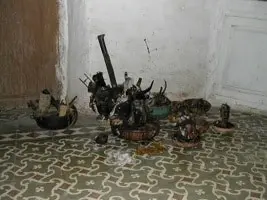 Authorities also discovered an assortment of “voodoo paraphernalia,” a blood splattered altar of sacrifice, cheap rum, human body parts, animal bones, chicken and goat heads, as well as the witch’s cauldron filled with the foul mixture of blood and flesh.
Authorities also discovered an assortment of “voodoo paraphernalia,” a blood splattered altar of sacrifice, cheap rum, human body parts, animal bones, chicken and goat heads, as well as the witch’s cauldron filled with the foul mixture of blood and flesh.
The human sacrifices offered to Satan were people who were abducted off of the streets, locals and otherwise. Tapia sheds some light on those who performed homage by human sacrifice to their god:
“In their wicked, distorted minds there was no seriousness. They thought they had performed some kind of heroic deed for the Devil. They believed that by sacrificing innocent human beings, their loads of marijuana would have an invisible shield of protection from law enforcement officers. They were moving an average of one thousand pounds a week across the border.”

Adolfo Constanzo
The ringleaders of the group, Adolfo Constanzo and Sara Aldrete, were both immersed in the occult and sold out to its application in order to gain prosperity. Carl Raschke, considered a leading authority on the occult, sets forth:
“Constanzo, like his American counterparts who had steeped themselves in the fashionable black arts as dictated over the years by such magical luminaries as Aleister and Anton LaVey, founder of the Church of Satan, could only be called a Satanist.”
Constanzo’s group was wound up in a voodoo type religion known as Santeria. Santeria encapsulates a ritualistic magic that slowly evolved to become a major religion in the Central America’s. Its foundation is the occult and it’s basic tenure parallels Satanism as defined by the chief Satanist of the twentieth century, Aleister Crowley. Migene Gonzalez-Wippler, author of Santeria: African Magic in Latin America, and devout follower as well defines Santeria through comparison:
“The English magician Aleister Crowley defined magic as the ability to effect changes in consciousness in accordance with the will of the magician. This definition agrees with the magical principles of Santeria.”
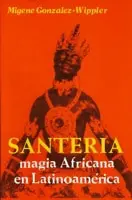 Constanzos and Aldrete’s actions resulted from obedience to occult powers. Santeria’s all encompassing philosophy of Crowley’s motto, “Do What Thou Wilt,” allowed them the liberty to snuff out the lives of innocents. In the occult and Satanism there is no overall value system, no universal rules concerning sex, drinking, drugs, lying, etc. Professor Mercedes Sandoval, of Miami-Dade Community College underlines this very point. She says, “Santeria has no moral stance. It doesn’t make judgements in your life. It doesn’t say no to anything.”
Constanzos and Aldrete’s actions resulted from obedience to occult powers. Santeria’s all encompassing philosophy of Crowley’s motto, “Do What Thou Wilt,” allowed them the liberty to snuff out the lives of innocents. In the occult and Satanism there is no overall value system, no universal rules concerning sex, drinking, drugs, lying, etc. Professor Mercedes Sandoval, of Miami-Dade Community College underlines this very point. She says, “Santeria has no moral stance. It doesn’t make judgements in your life. It doesn’t say no to anything.”
What led to the gruesome mass sacrifice of so many people in Matamoros? The motivations for the deranged killers sprouted not only from the Crowley-like Santeria, but also the big screens of Crowley-like Hollywood. Constanzo was known for giving psychic readings to many musicians and famous Hollywood celebrities. But aside from this, the greatest factor that most influenced him was a movie called The Believers. This film was actually a major contributor for inspiring Constanzo and his cronies to recapitulate what they viewed.
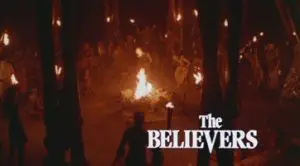 In 1987, director John Schlesinger made The Believers, starring Martin Sheen and Jimmy Smits. The film was about a New York City cult that sacrifices children to gain money and power and clearly bases much of its ritualism on Santeria. According to the confessions of the accused, their distinct style of religion had been based on the supernatural Hollywood movie. Occult researcher Carl Racshke confirms:
In 1987, director John Schlesinger made The Believers, starring Martin Sheen and Jimmy Smits. The film was about a New York City cult that sacrifices children to gain money and power and clearly bases much of its ritualism on Santeria. According to the confessions of the accused, their distinct style of religion had been based on the supernatural Hollywood movie. Occult researcher Carl Racshke confirms:
“It is not at all surprising that Constanzo and Sara Aldrete were infatuated with the movie The Believers. The magical practitioners in the film are portrayed as insuperable and almost all knowing.”
The Matamoros group used the principles outlined in the movie as a springboard for executing their occult beliefs. Serafin Garcia, close participant with Constanzo and Aldrete totally succumbed to the message in the film. After being arrested, Garcia confessed to George Gavito the gravity of the situation. Gavito recalls:
“I remember I didn’t understand what he was telling me. I said, ‘Is it Santeria?’ And he said, ‘Yeah, yeah, Santeria, voodoo, man.’ And then he kept on saying, ‘The Believers, The Believers, The Believers.’”
Although unfamiliar with the ins and outs of Santeria, The Believers programmed Garcia and provided a mind-altering influence for his torturous slayings. Gavito adds:
“Elio made [Serafin] Garcia a priest, but Garcia didn’t really know what he was practicing because all he had on his mind was the movie.”

Sara Aldrete
Sarah Aldrete, called the most “wickedly depraved” of the bunch by an interviewing officer, used the movie to recruit members into avenues of the occult. Rolling Stone magazine wrote:
“[There is]…a story making the rounds that tells of the night Aldrete persuaded three male friends to screen a video of The Believers. After the film, say the students, Aldrete stood up and began to preach in strange tones about the occult. ‘They had been drinking and they just thought she was trying to be spooky,’ says one student who knows the boys, ‘but they look back on it now and think she must have been serious.’”
Satan’s messages are without a doubt absorbed by the world and used as elusive tools for reconditioning. Incidents such as this proves that even movies that are not blockbuster types with full blown special effects have incredible potency to muster the sinful nature within man. Chief Deputy Carlos Tapia warns: “Don’t get caught unawares like we did… Do yourself a favor. Save your kids!” Sadly, when the news of the sacrifices broke, instead of people avoiding evil and saving their kids, they jeopardized them and gravitated to it. Gary Provost, in his documentary The True Story of the Satanic Cult Killings, wrote:
“In video rental shops everywhere, clerks noticed a run on the film The Believers. When news stories reported that the movie had been used as a recruiting film by Constanzo’s youth cult members, the stores had thousands of calls for the film.”
If Hollywood says human sacrifices are acceptable, then acceptable they must be! Sadly, Mark Kilroy and a host of others had to lose their lives as a result. Don’t allow your brain to be twisted and programmed by what the world defines as acceptable and innocent shows. Spend time with the Lord, learn of Him and let each day of your life be a devotion to Him.
Often referred to as Santeria’s ‘evil twin,’ Palo Mayombe is considered the darkest and most feared of all the black magic practices. ARM investigators have, on several occasions, received warnings to steer clear for their protection. A single personal item left behind is enough to use in a ceremony for severe spells and even death!
In the dark world of Palo Mayombe, many pets such as horses, dogs, and cats get stolen from loving families where they are traded for a monetary profit and subjected to brutal acts for ritual sacrifices. ARM has documented dogs and cats confined in small cages and exposed to the extremities of 120-degree heat, with only the blood of other animals to drink, a ‘step’ in preparation for up and coming ceremonies and only amplifies the degree of cruelty these innocent animals endure as “food for the gods.”
There are many intricate details when setting up ceremonies in Palo Mayombe, and for the most deathly curses, large animals are sacrificed, such as horses that are often decapitated. To the highest extreme, human bones and skulls are part of the ceremony and obtained by grave robbing or taking a life. (They also commit human sacrifice, but they will not admit that publicly)
In 2012 ARM discovered and investigated the largest Palo Mayombe site in NW Miami Dade in the US.
spacer
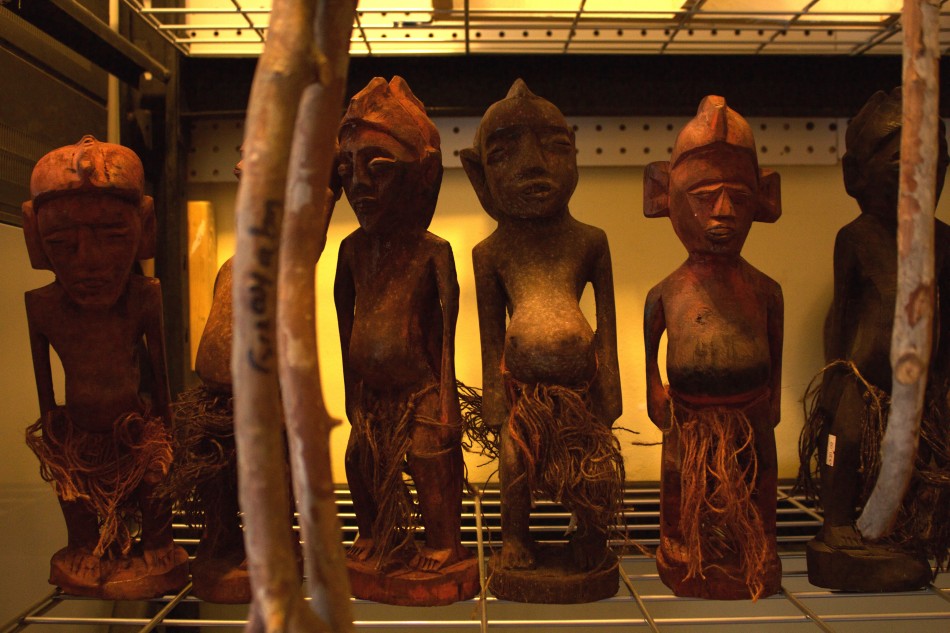
Enox J. Rios became an Iyawo this past April. And so for a year and seven days he must only dress in white. He is to eat all his meals on the floor. He is forbidden from looking into a mirror and cannot be outside after dark. He’s also not allowed to make any physical contact with the uninitiated. That means no handshakes.
As Yawo, Rios is a newly ordained priest of an ancient diaspora religion brought to Cuba by Congolese slaves. From Cuba it spread throughout the Caribbean, to the Dominican Republic, Colombia, Venezuela, and later to the US. It’s called Palo Mayombe, and its dark rituals involving human and animal remains and even grave robbing, is practiced in extreme secrecy. Like another Afro-Caribbean religion, Santeria, thousands of Latino New Yorkers are adherents of this syncretic faith which involves ritual dance, song, and drumming.
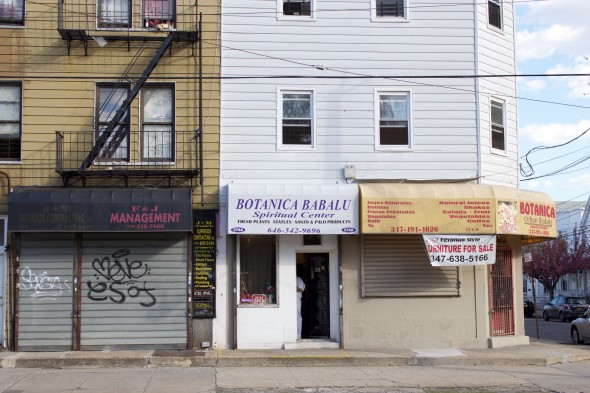
Botanica Babalu in the Bronx. Photo by Neil Giardino.
As a palero, Enox said he has been ordained or “crowned” ocha. This means that an Orisha, or holy being of his faith, is aligned with his inner head. In essence, it gives him the ability to act as a spiritual medium.
“It’s very dark. Very draining. But if it’s used for the betterment of the people and for protection, it is amazing,” said Rios.
The spirits that paleros are in contact with are both ancestral and of the natural world. Worship for paleros like Rios centers on communication with these deities by using iron or clay pots called ngangas. The nganga is to a palero what an alter is to a Catholic priest. Palo means stick in Spanish. And that’s what goes into the pot along with earth and bones. But that’s not all that goes into a gnanga.
“You want the spirit to keep you safe from a gun, to keep you safe from a machete, from a blade, somebody pulling out a blade on you. So we implement all those things in the pot,” explains Rios.
Palo faithful believe that a spirit of the dead also lives inside. The spirits of Palo communicate through ordained mediums like Rios. Earthly items like guns or knives help the palero channel these spirits and summon protection from them.
One patron needs a blessing before a job interview. Another isn’t coping with a death in the family. Some are trying to keep their marital vows sacred. Requests to keep husbands or wives faithful are common. Rios said instead he focuses on light and healing. But he explains that some paleros not only overcharge in times of crisis, but also use the spirits in their ngangas recklessly, to harm or worse.

.
“You can kill with a nganga. That’s how dark it is. It’s like a dog. Somebody comes into your back yard and your dog is trained. If that dog gets loose, who knows what you’re going to be in by the time they get the dog off of you,” he said.
Palo is almost always linked to Santeria. And ritual music and dance is fundamental to both. There is one main distinction: Santeria comes from the Yoruba people from Nigeria and Palo Mayombe comes from the Congo. Since Congolese slaves were brought to the Caribbean much earlier than the Yoruba, it’s harder to trace their music and culture directly back to Africa. In other words, Palo’s African origins are darker and more mysterious.
Peter Manuel is a professor in the department of Art and Music at John Jay College who has written extensively about music of the Caribbean. “Palo songs have some Congolese words in them, but mixed with a lot of Spanish. It’s just more syncretic and more acculturated,” he said. Manuel added that although the often feverish dance, pounding drums, and call and response incantations of Santeria and Palo are similar, tracing Santeria to the Yoruba is much easier because these Nigerian slaves were brought to the Caribbean as late as the 19th century. That direct line between Palo and the Congo is much more indistinct.
One similarity in both Palo and Santeria is ritual sacrifice. Every so often news about sacrifice of animals makes headlines in Greater New York City. When asked about this, Enox J. Rios is unequivocal. “This is an Afro-Caribbean religion and it’s one of the oldest religions. This is the way it’s been done. It’s tradition. But there’s room for growth.” he said.
And as an initiated Yawo of Palo Mayombe, Rios will now embark on his year and seven days of austerity as an ordained palero. He acknowledges the darkness of his religion, but says he’ll continue to use it for the sake of wellness and healing.
spacer
Our Universities are teaching this Spiritual Practice
In this course you will better understand how the events and people in Africa shaped what would later become the religion of Palo Mayombe in Cuba. This course is made up of seven lectures that are meant to easily explain the origins of the Palo Mayombe Religion as well as introduce you to the different denominations of Palo that exist today. You will also gain a better understanding of Palo Mayombe’s relaionship with other religions including Catholicism and other African religions.
Oftentimes confused with Voodoo and Santeria, Palo Mayombe is a religion that hails from the people who were known as “Congos” in Cuba. These people weren’t just those that come from the present day Democratic Republic of the Congo but from a much broader area. They believed in much more than magic, this is a story of politics and intrigue that includes triumph, deceit, war and much more.
Rituals and Sacrifice (Ebó)

Ebó is a ritual offering or sacrifice as dictated by divination. Ebó is one of the cornerstones of the Santeria religion, and it is the tool that we have been given by the Orishas to change our fate and return our lives to a balanced and healthy state.
Ebo takes many forms. It can be an offering of fresh fruits, ritual baths, offerings of cooked foods, undergoing initiation, receiving an orisha, or animal sacrifice to name a few. (ya, they are not going to name Human Sacrifice, though it is most assuredly practiced.) In every case, ebó is marked through divination (either through obí divination, diloggun divination or Ifá divination) as the required remedy to bring a person out of an unbalanced place and put them back into a state of balance. (They are talking about the idea of balance being equal good and Evil in everyone and everything. That is a pagan teaching. That promotes doing evil as a normal part of life) A properly recommended ebo can create miraculous change in a person’s life, and it can literally turn their life course in a new direction. (Ya, just look at what it has done for human trafficers, and drug lords.)
Addimu (Cooked Offerings)
Addimús are cooked foods that are token offerings of love and thanks to the orishas or to the ancestors. (Call it what it truly is, WORSHIP. This has been the manner of worship for pagan gods since the Fallen Angels came to earth.) These are typically foods that the Lucumi (Lukumi) people ate in their diet. There are a slew of addimús that a diviner can mark for a person to offer, but each orisha typically likes a certain set of foods. (So the demon spirits dictate what they will receive for an offering, dependent on what is being requested of them.) While Chango might like amalá ilá (cooked cornmeal and okra), Oyá might like a nice chocolate pudding. Traditional addimus include black eyed pea fritters, corn tamales, balls of toasted wheat flour and condensed milk, boiled ñame root, or ochinchín (an egg scramble made with shrimp and greens). Addimús must be marked in divination and then placed beside the orisha with a prayer of offering and thanks. At the Santeria Church of the Orishas we prepare addimus for clients and place them on our orisha shrines. This is a simple service that is done in conjunction with diloggun divination in our church.
Isoguí (Fruit offerings)
Another form of ebó is to offer the orishas their favorite fresh fruits. Typically these are best if all picked from the same tree – or (the modern day equivalent) purchased in the same store. Each orisha has fruits that are their favorite. Isoguí should be marked through divination as with all other ebbos, but they can be given as a token of the heart as well. Fruits are always a safe bet when making offerings to the orishas. If you visit our church and want to bring an offering for the orishas, fruits are probably the best choice but ask one of our pastors before deciding what to bring.
Eyebale (Blood sacrifice)

Occasionally a major ebó will require blood sacrifice. This is one of the more controversial parts of the Santeria faith, but we want to demystify the practice for those who may not understand its function. Within Santeria blood sacrifice is only done with the kinds of animals you’d find on a farm: chickens, roosters, goats, sheep, pigeons, etc. It is a required part of any initiation (Elekes, Warriors, Orisha Addimú, Kariocha) and without blood sacrifice you do not have the presence of the orishas in that ritual, and you do not have a legitimate consecration. This is an ancient and traditional practice upheld by the culture bearers of our religion and is not something that can be excluded in said rituals.
Animal sacrifice is something that should be done with great respect to the animal, making sure they are given plenty of food and water as well as room to move about while in holding prior to the ritual. The sacrifice method commonly used in Santeria involves the severing of the carotid arteries with a knife to cause the animal to pass out before it dies. This is one of the most humane ways of killing an animal and is nearly identical to the way animals are handled with Kosher and Halal religious slaughter techniques. Most often the animals for major initiations are then butchered and the meat is cooked and shared with the community. The orishas or ancestors eat the blood, and the people eat the meat. It is an act of communion with the spirits.
This serious ebó is done when it is absolutely necessary. At the Santeria Church of the Orishas, we try to find simpler solutions like addimus before resorting to eyebale. Eyebale (Animal Sacrifice) is a legally protected form of religious practice according to the decision by the Supreme Court of the United States in the 1993 case of The Church of Lukumi Babalu Aye vs. the City of Hialeah. Our church action committee, SAFE – Santeros Against Fraud and Exploitation, takes a strong stance on the ethical treatment of animals prior to sacrifice and adherence to proper ritual slaughter of animals.
Other Religions Alternative Religions
:max_bytes(150000):strip_icc():format(webp)/388606451_be03123c58_o-589802055f9b5874eed63310.jpg)
Ebbos (or Ebos) are a central part of Santeria practice. Humans and orishas both need an energy force known as ashe in order to succeed; orishas, in fact, need it in order to survive. So if one would like to be favored by the orishas, or even just pay respect to these beings that are intimately involved with forces in the physical world, one must offer ashe. All things have some quantity of ashe, but nothing is more potent than blood. Sacrifice is a method of delivering that ashe to the orishas so they, in turn, can use ashe for the petitioner’s benefit.
Types of Offerings
Animal sacrifices are by far the most known type of offerings. However, there are many others. One may need to pledge to do a particular action or abstain from certain foods or activities. Candles and other items may be burned, or fruits or flowers may be offered. Singing, drumming, and dancing also contribute ashe to the orishas. (But as stated above – NOTHING IS MORE POTENT THAN BLOOD, AND THEY REQUIRED SACRFICE!)
Creating Talismans
Food is the usual offering in the creation of talismans. A talisman provides certain magical qualities to the person wearing it. In order to infuse an item with such influence, ashe must first be sacrificed.
Votive Offerings
Those who wish to more generally attract the positive aspects of an orisha might make a votive offering. These are items that are left at a shrine or otherwise put on display as a gift to the orishas.
Animal Sacrifice Where the Meat is Eaten
Most ceremonies that involve animal sacrifice (or human sacrifice) also involve the participants eating the flesh of the slaughtered animal. The orishas are only interested in the blood. As such, once the blood is drained and offered, the meat is eaten. Indeed, the preparation of such a meal is an aspect of the overall ritual. (This is very significant as it unites the one making the offering with both the one sacrificed and the spirit to whom it is offered. It is call communion with the spirit.)
There’s a variety of purposes for such a sacrifice. Initiations require blood sacrifice because the new santero or santera must be able to be possessed by the orishas and interpret their wishes.
Santeria believers do not merely approach the orishas when they want something. It is a continual reciprocal arrangement. Blood may therefore be sacrificed as a way of saying thank you after the receiving of good fortune or the resolution of a difficult matter.
Animal Sacrifice When Meat is Discarded
When the sacrifice is made as part of purification rituals, the meat is not eaten. It is understood that the animal takes the impurity upon itself. Eating its flesh would simply put the impurity back into everyone who partook of the meal. In these cases, the animal is discarded and left to rot, often in a location of importance to the orisha being approached.
Legality
The Supreme Court of the United States has ruled that religious animal sacrifice cannot be made illegal, as it falls under freedom of religion. However, those that perform animal sacrifices do need to follow certain rules to limit the suffering of the animals, just as slaughterhouses have to do the same. Santeria communities do not find these rules to be burdensome, as they have no interest in making the animals suffer.
What is becoming more controversial is the discarding of purification sacrifices. The discarding of carcasses in certain locations is important to many believers, but that leaves local city workers the task of cleaning up the rotten bodies. City governments and Santeria communities need to work together to find compromises on the subject, and the Supreme Court also ruled that related ordinances should not be overly burdensome to believers.
spacer
Santeria, a syncretistic Caribbean religion:
Conflicts concerning Santeria sacrifices – religious tolerance
Cult Sacrificing Animals During Santeria Rituals Busted In Spain
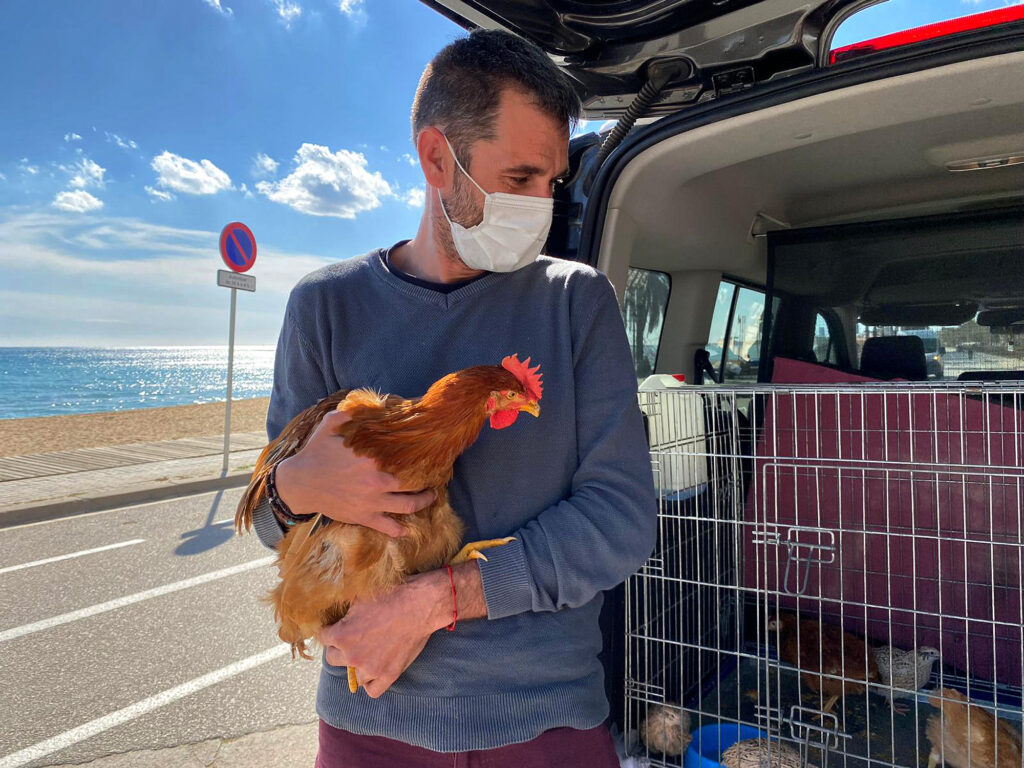
Footage compiled by AnimaNaturalis after the investigation shows members inspecting a large trash bag that contained partially beheaded chickens. A baby goat with its head completely severed is then placed next to it. Another clip shows the 13 animals that were rescued.
“We watched the band for weeks, until one day, we managed to see how two men loaded with garbage bags came out of the portal,” Aïda Gascón, director of AnimaNaturalis, said in a press release. “They threw the bags into the container, and when they left, we went inside. The bodies of the animals, still warm, were decapitated.”
spacer
‘Hundreds’ Of Headless Goat Carcasses Reportedly Dumped Into Georgia River, Investigators Suspect Satanic Santeria Rituals
Why has this been ignored for so long?

A local Georgia news outlet has been investigating reports of “hundreds” of headless goat carcasses seen floating in the Chattahoochee River.
According to WSB-TV Channel 2 Action News, someone has been dumping “hundreds of decapitated goats” into the river for years. “Lately it’s become a lot more frequent.”
ATLANTA — Channel 2 Action News is investigating headless goats found floating in the Chattahoochee River. Someone has dumped hundreds of decapitated goats over the past few years.
The two traveled along the river when they noticed the decapitated carcass of a goat floating in the water near the Interstate 20 bridge on the border of Fulton County and Cobb County. “There’s a goat,” said Ulseth.
A witness provided cell phone video footage of the goats being dumped into the river from a I-20 bridge. The video shows the carcasses splashing into the river after being dumped off the bridge, however it is unclear who was behind it. “He actually hears the body splashing down, not only in the middle of the night, but he told me he hears them in the middle of the day,” Ulseth said.
“These goats have to be coming from somewhere, but we haven’t been able to determine who’s buying the goats, who’s providing the goats or actually how they are making their way here in the river,” said Ulseth.
It is now believed that the situation stems from satanic Santeria ritual blood sacrifices.
In 2019, Channel 2 Action News did a story about people leaving dead chickens, goats’ heads and coconuts near railroad tracks in metro Atlanta.
It turns out it was part of a religious ceremony for the followers of Santeria, a religion that mixes West African culture with Cuban Catholicism.
Channel 2 talked to a Shango priest in 2019, who explained the significance of the goats.
“We use a he goat as also a victory. Then we use she goat for the baby, for the for also for the blessing. That is the significance of all these animals that we use,”Akinton Shingods Anjoula said.
The local news outlet had reached out to law enforcement for answers, but the Georgia State Patrol and Fulton County Police told them they didn’t have any reports about the headless goats. They are currently waiting for an open records request from Cobb County Police.
“Over the past couple of years, I’ve seen a couple hundred, but never more than 20 to 30 at one given time like we’ve started to see here lately,” Ulseth said. “This is drinking water for 5 million people, and we all have to do our part to take care of it.”
spacer
spacer
A wild pig and beheaded chickens were dumped behind the sign of a gated community in Cape Coral. Officers believed it was linked to Santeria, a religion using livestock in sacrificial ceremonies.
Dumping animal remains instead of burning or burying them at least two feet underground is a second-degree misdemeanor. Officers dialed “311” for Waste Pro to pick it up.
Before crews arrived, a FWC officer pulled up wearing gloves to examine it. FWC confirmed it is now investigating and does not want to speculate a link to religion but does not believe this was Animal Cruelty.
A Waste Pro truck arrived shortly after to pick up the remains. Some neighbors were not happy with how long it took. Dan Yaple said, “It shouldn’t take longer than an hour for someone to respond to and move. I mean there’s certainly a lot of tax money being paid to do these sorts of things.”

“>A pile of dead animals found in Cape Coral, Florida, is suspected to be the result of a ritual sacrifice that was dumped behind a community’s decorative signage.
Santeria followers are known to practice ritual animal sacrifice, which is permitted under Florida Statutes “to protect freedom of religion.”
However, the slaughtering must be handled quickly and humanely, and there are strict guidelines for disposal of the dead animals — something that was not done in this case.
“A person should dispose of an animal carcass by burning or burying it at least two feet below ground,” according to information provided by the Cape Coral Police Department.
“The ‘dumping’ of an animal carcass on any public road or right-of-way” is considered a second-degree misdemeanor, police said.
The United States Commission on International Religious Freedom reports Santeria is a widely practiced Cuban religion steeped in an African traditions.
Florida Fish and Wildlife officials are investigating the case. “The FWC takes these reports very seriously and encourages the public to report any sightings or any information regarding this incident to the FWC,” the department told McClatchy News.
Neighbors in Emerald Cove were appalled at the discovery, noting the carcasses smelled horribly, requiring passersby to wear a mask, according to WBBH.
All the chickens had been beheaded, the station reported.
spacer


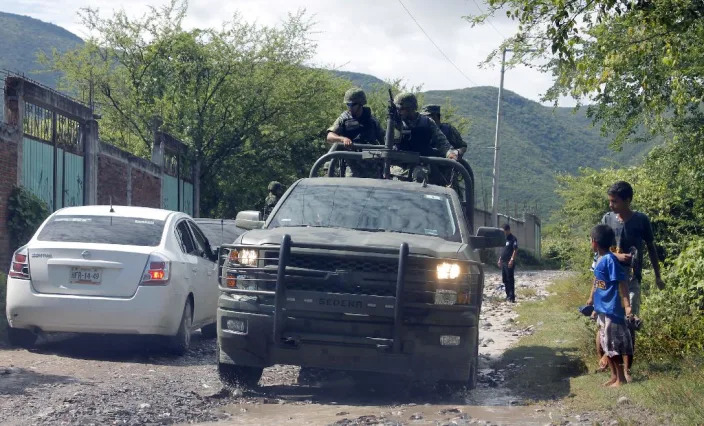

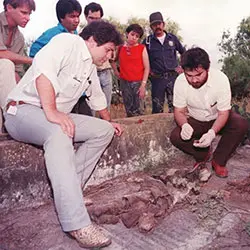



:quality(70)/arc-anglerfish-arc2-prod-tronc.s3.amazonaws.com/public/RCQF34UYUFK2LQZU56V5GUWGZI.jpg)
:quality(70)/arc-anglerfish-arc2-prod-tronc.s3.amazonaws.com/public/XRFXMAYSBOXPFPJYHOH3ER5XTU.jpg)
:quality(70)/arc-anglerfish-arc2-prod-tronc.s3.amazonaws.com/public/FC7T6472AWXSMOGJ2PLUAQQYJE.jpg)
:quality(70)/arc-anglerfish-arc2-prod-tronc.s3.amazonaws.com/public/LRLM6FWUH3QJ4C6CHPYZU7YUNU.jpg)
:quality(70)/arc-anglerfish-arc2-prod-tronc.s3.amazonaws.com/public/QAASTPYWKG24TMC32K76XPCTY4.jpg)
:quality(70)/arc-anglerfish-arc2-prod-tronc.s3.amazonaws.com/public/KBPMTJDRJOKZP5VJOZWLDLPKT4.jpg)
:quality(70)/arc-anglerfish-arc2-prod-tronc.s3.amazonaws.com/public/ZPVLLBZUTEUGZ7FAUES6TYMFBA.jpg)
:quality(70)/arc-anglerfish-arc2-prod-tronc.s3.amazonaws.com/public/OWS2C6QFRYIM56K3T6NSLZV4SA.jpg)
:quality(70)/arc-anglerfish-arc2-prod-tronc.s3.amazonaws.com/public/LZP2DM5G66UOC2JAO7B5IHEGLA.jpg)
:quality(70)/arc-anglerfish-arc2-prod-tronc.s3.amazonaws.com/public/ZPAP2E7BOWV5JLGZ35TDRV4D3U.jpg)
:quality(70)/arc-anglerfish-arc2-prod-tronc.s3.amazonaws.com/public/GXJSVL5NIIC7JXWE2FMNJJGEZI.jpg)
:quality(70)/arc-anglerfish-arc2-prod-tronc.s3.amazonaws.com/public/NYWXCYGBGVNEZ7ML5ZN36MGFYU.jpg)
:quality(70)/arc-anglerfish-arc2-prod-tronc.s3.amazonaws.com/public/EH42OTJVA5O5XXZCG7YHQ5UNSQ.jpg)
:quality(70)/arc-anglerfish-arc2-prod-tronc.s3.amazonaws.com/public/PMBHERQ5YX4KJKG5KLYEMKO22I.jpg)
:quality(70)/arc-anglerfish-arc2-prod-tronc.s3.amazonaws.com/public/EBZKSQEHAYKCHMXNWX74EZSJZE.jpg)
:quality(70)/arc-anglerfish-arc2-prod-tronc.s3.amazonaws.com/public/7F6TTPXQ2GW3PUEQDAXDYFDETM.jpg)
:quality(70)/arc-anglerfish-arc2-prod-tronc.s3.amazonaws.com/public/MWHWTOZ5HIVIZMBQAZHST7AQIE.jpg)
:quality(70)/arc-anglerfish-arc2-prod-tronc.s3.amazonaws.com/public/5KNL6ZNQZNF627S2SHVOFZP3SU.jpg)
:quality(70)/arc-anglerfish-arc2-prod-tronc.s3.amazonaws.com/public/FA7H2MSOUVYYOKECAR7BEC4B4Y.jpg)